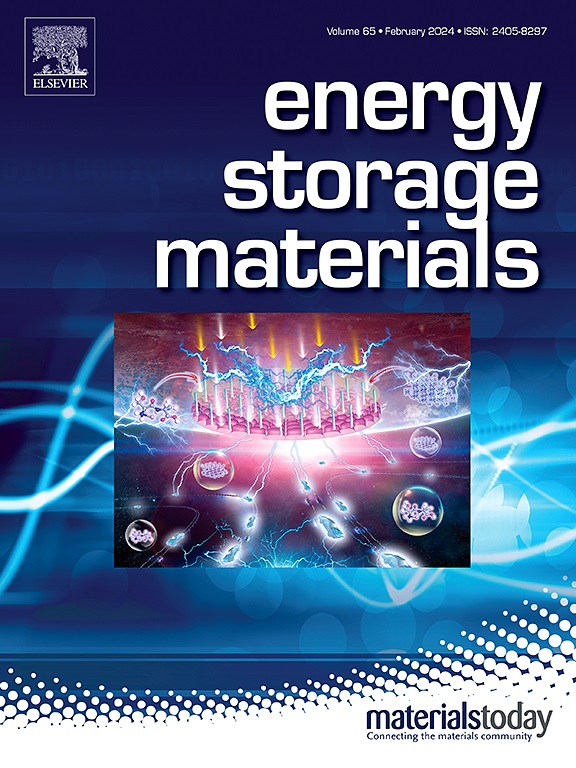Improving the rate performance of lithium metal anodes: In-situ formation of 3D interface structures by mechanical mixing with sodium metal
IF 18.9
1区 材料科学
Q1 CHEMISTRY, PHYSICAL
引用次数: 0
Abstract
Lithium metal anodes (LMA) increase the energy density of lithium-ion batteries, but the formation of lithium dendrites above a critical charging current (CCD) is still a severe safety issue that limits their wide industrial application. In this work, we present a simple, scalable method to improve the properties of LMA and increase the CCD by physical mixing with a small amount of Na metal, leading to a formation of self-organized 3D interfacial structures during cycling. The physical premixing of Li and Na metal results in excellent dispersion of the metals without phase separation or clustering. To demonstrate the effectiveness of these LiNa anodes in solid-state cells with oxide-ceramic Li6.45Al0.05La3Zr1.6Ta0.4O12 (LLZO) separators, by melt-quenching them directly onto the LLZO surface. The application of a special formation protocol during cycling leads to the in-situ formation of a 3D Na-metal interfacial structure, which improves the cell performance. The symmetric cells prepared in this way were operated without external pressure (0.1 MPa) and showed record CCDs for planar interfaces of over 5.0 mA∙cm−2, cycling stability of over 1200 cycles, and a total stripping capability of up to 100 µm Li metal, corresponding to a capacity of 21 mAh∙cm−2. Most remarkably, our approach resulted in a very low impedance of the Li/LLZO interface, which remained constant even at high stripping/plating rates. The new approach provides an industrially scalable method for fabricating next generation LMAs with an inherently reduced tendency to dendrite formation, which can be readily utilized in a variety of next-generation lithium batteries.提高锂金属阳极的速率性能:通过与金属钠的机械混合原位形成三维界面结构
锂金属阳极(LMA)提高了锂离子电池的能量密度,但超过临界充电电流(CCD)的锂枝晶的形成仍然是一个严重的安全问题,限制了其广泛的工业应用。在这项工作中,我们提出了一种简单、可扩展的方法,通过与少量金属Na的物理混合来改善LMA的性能并增加CCD,从而在循环过程中形成自组织的3D界面结构。Li和Na金属的物理预混使金属具有良好的分散性,没有相分离或聚类。为了证明这些丽娜阳极在固体电池中的有效性,使用氧化陶瓷Li6.45Al0.05La3Zr1.6Ta0.4O12 (LLZO)分离器,将它们直接熔淬到LLZO表面。在循环过程中应用特殊的形成协议导致原位形成3D na -金属界面结构,从而提高了电池性能。用这种方法制备的对称电池在没有外部压力(0.1 MPa)的情况下工作,显示出超过5.0 mA∙cm−2的平面界面的ccd记录,循环稳定性超过1200次循环,总剥离能力高达100µm Li金属,相当于21 mAh∙cm−2的容量。最值得注意的是,我们的方法使Li/LLZO界面的阻抗非常低,即使在高剥离/电镀速率下也保持不变。新方法为制造下一代lma提供了一种工业上可扩展的方法,该方法具有固有的减少枝晶形成的倾向,可以很容易地用于各种下一代锂电池。
本文章由计算机程序翻译,如有差异,请以英文原文为准。
求助全文
约1分钟内获得全文
求助全文
来源期刊

Energy Storage Materials
Materials Science-General Materials Science
CiteScore
33.00
自引率
5.90%
发文量
652
审稿时长
27 days
期刊介绍:
Energy Storage Materials is a global interdisciplinary journal dedicated to sharing scientific and technological advancements in materials and devices for advanced energy storage and related energy conversion, such as in metal-O2 batteries. The journal features comprehensive research articles, including full papers and short communications, as well as authoritative feature articles and reviews by leading experts in the field.
Energy Storage Materials covers a wide range of topics, including the synthesis, fabrication, structure, properties, performance, and technological applications of energy storage materials. Additionally, the journal explores strategies, policies, and developments in the field of energy storage materials and devices for sustainable energy.
Published papers are selected based on their scientific and technological significance, their ability to provide valuable new knowledge, and their relevance to the international research community.
 求助内容:
求助内容: 应助结果提醒方式:
应助结果提醒方式:


